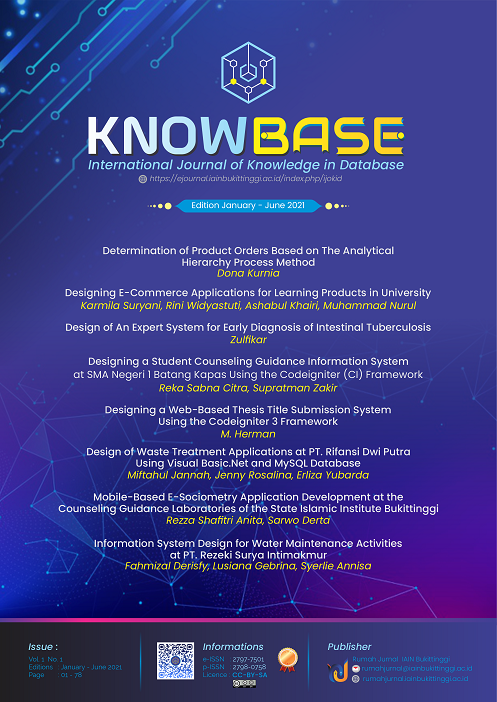Design of An Expert System for Early Diagnosis of Intestinal Tuberculosis
DOI:
https://doi.org/10.30983/ijokid.v1i1.5005Keywords:
Expert system, Intestinal TB, Fordward Chaining, ADDIEAbstract
WHO in 2013 released data in the Global Tuberculosis Report that 8.6 million more people were positive for TB, and 15.12% of them died. One of the causes of death due to tuberculosis is too late to know when it is infected and too late to get treatment. For an initial diagnosis of whether someone has TB, they can immediately go to a hospital or use a computer application that has an expert's ability. This study aims to design an expert system for the early diagnosis of intestinal tuberculosis using the Forward Chaining method. Expert System is one part of Artificial Intelligence that can create a computer program to provide decisions and analysis like an expert or expert in a particular field. The research method used in this study is the Research and Development method with the ADDIE approach. The expert system for early diagnosis of intestinal tuberculosis is designed by making a decision tree diagram to find out the rules needed to diagnose whether a person has intestinal tuberculosis from the symptoms experienced. The formulation of the problem or the rules needed for the initial diagnosis of intestinal tuberculosis in this study was built using the Forward Chaining method. The output of this research is an Expert System in the form of a Stand-Alone application that is built with the Visual Basic Programming Language, which can provide diagnostic results whether a person suffers from intestinal tuberculosis from the symptoms entered into the Expert System Interface.
References
Putri. P.A, Mustafidah. H, “Sistem Pakar untuk Mendiagnosa Penyakit Hati Menggunakan Metode Forward Chaining,†Jurnal Informatika., vol. 1, no.4, pp. 143–155, 2011.
Deepa. S.T, Packiavathy. S.G, “Expert System For Car Troubleshooting,†International Juornal For Research In Science & Advance Technologies., vol.1, no.1, pp.046-49, 2012.
Patra. S.K, Sahu. D.P, Mandal. I, “An Expert System for Diagnosis of Human Diseases,†Internasional Juornal of Computer Applications., vol.1, no.13, pp. 71-73, 2010.
Patel. M, Atul. P, Paresh. V, “Rule Based Expert System for Viral Infection Diagnosis,†International Journal of Advanced Research in Computer Science and Software Engineering., vol. 3, no.5, pp. 591-595, 2013.
World Health Organization. “Global tuberculosis report 2013†https://apps.who.int/iris/handle/10665/91355, Oct. 21, 2013 [Sep. 12, 2014]
Kementrian Kesehatan Repulik Indonesia, Pharmaceutical Care. Direktorat Bina Farmasi Komunitas dan Klinik Bina Kefarmasian, 2015
Wijaya. M.K.I, “Pengetahuan, Sikap dan Motivasi Terhadap Keaktifan Kader Dalam Pengendalian Tuberkulosis,†Jurnal Kesehatan Masyarakat., vol.8, no.2, pp. 137 – 144, 2013
Lyanda. A, “Rapid TB Test,†Jurnal Tuberkulosisi Indonesia., vol.8, pp.12-17, 2012
Ade Djohar. M, Metode Penelitian Teknik Informatika. Yogyakarta : Deepublish, 2014, pp. 49-53
Morrison. G.R, Ross. S.M, Kalman. H.K, Kemp. J.E, Designing Effective Instruction. USA : John Wilwy & Son, 2011, pp. 12-15
Downloads
Published
How to Cite
Issue
Section
Citation Check
License
Authors who publish with this journal agree to the following terms:
- Authors retain copyright and grant the journal right of first publication with the work simultaneously licensed under a Creative Commons Attribution License that allows others to share the work with an acknowledgment of the work's authorship and initial publication in this journal.
- Authors are able to enter into separate, additional contractual arrangements for the non-exclusive distribution of the journal's published version of the work (e.g., post it to an institutional repository or publish it in a book), with an acknowledgment of its initial publication in this journal.
- Authors are permitted and encouraged to post their work online (e.g., in institutional repositories or on their website) prior to and during the submission process, as it can lead to productive exchanges, as well as earlier and greater citation of published work (See The Effect of Open Access).



